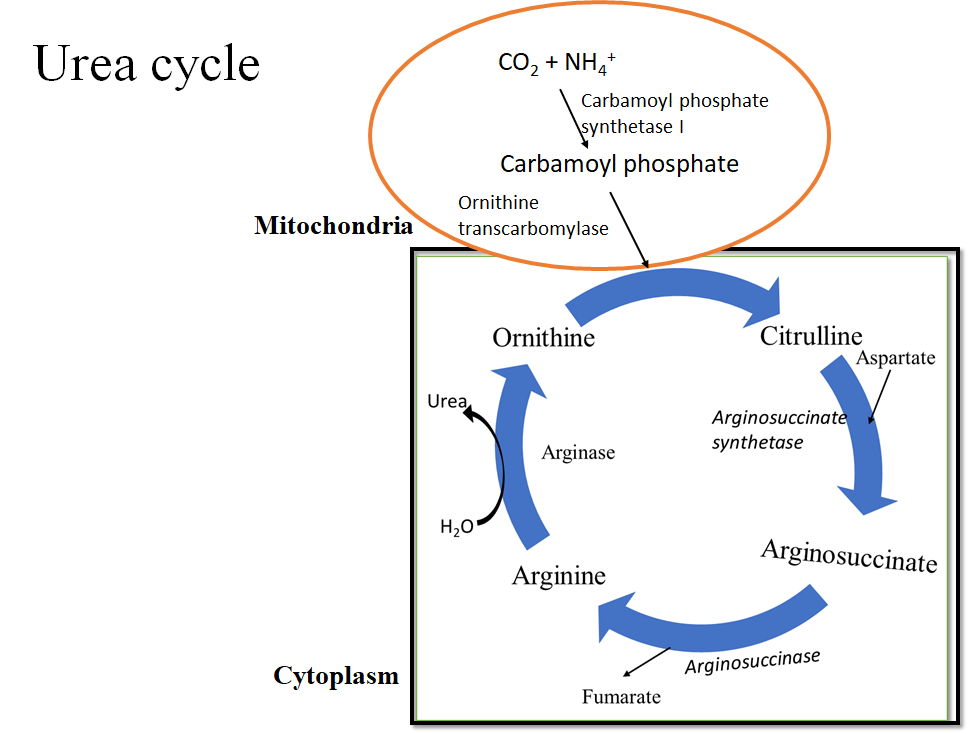
The end product of the ornithine cycle is
(a) Ammonia
(b) Uric acid
(c) Urea
(d) CO2
Answer
572.7k+ views
Hint: Ornithine cycle takes place in the liver of ureotelic organisms such as amphibians and mammals. It is the most important means of assimilation of ammonia. Citrulline is an important intermediate generated in this cycle.
Complete answer:
The end product of the ornithine cycle is Urea. The ornithine cycle transforms excess ammonia into urea in the mitochondria of the hepatocytes. The urea cycle is the biochemical pathway that converts nitrogen to urea for excretion from the body.
- Urea as excretory products is eliminated from the body mainly through the urine hence it is seen in ureotelic organisms such as amphibians and mammals.
- Ammonia, that is very harmful to humans, is transformed to urea, which is nontoxic, very soluble, and easily excreted by the kidneys.
- The urea discharged each day by a healthy adult, approximately 30 g, estimates for about 90% of the nitrogenous excretory products.
- Urea is formed in the urea cycle from ammonia and carbon dioxide, and the nitrogen of aspartate.
- The cycle occurs mainly in the mitochondria of the liver cells.
- The urea is produced which then enters the bloodstream and is filtered by the kidneys. It is ultimately excreted in the urine.
- This cycle was the first biochemical cycle to be identified by Hans Krebs and Kurt - Henseleit in 1932, about five years before the revelation of the TCA cycle. This cycle was explained in more detail later on by scientist Ratner and Cohen.

So, the correct answer is “Urea ”.
Note: In rare disease, genetic defects in the enzymes required in the cycle can occur which generally reveal within a few days of birth. The newly born child will generally experience varying periods of emesis and bouts of lethargy. Ultimately the newborn may slip into a coma and evolve into brain damage.
Complete answer:
The end product of the ornithine cycle is Urea. The ornithine cycle transforms excess ammonia into urea in the mitochondria of the hepatocytes. The urea cycle is the biochemical pathway that converts nitrogen to urea for excretion from the body.
- Urea as excretory products is eliminated from the body mainly through the urine hence it is seen in ureotelic organisms such as amphibians and mammals.
- Ammonia, that is very harmful to humans, is transformed to urea, which is nontoxic, very soluble, and easily excreted by the kidneys.
- The urea discharged each day by a healthy adult, approximately 30 g, estimates for about 90% of the nitrogenous excretory products.
- Urea is formed in the urea cycle from ammonia and carbon dioxide, and the nitrogen of aspartate.
- The cycle occurs mainly in the mitochondria of the liver cells.
- The urea is produced which then enters the bloodstream and is filtered by the kidneys. It is ultimately excreted in the urine.
- This cycle was the first biochemical cycle to be identified by Hans Krebs and Kurt - Henseleit in 1932, about five years before the revelation of the TCA cycle. This cycle was explained in more detail later on by scientist Ratner and Cohen.

So, the correct answer is “Urea ”.
Note: In rare disease, genetic defects in the enzymes required in the cycle can occur which generally reveal within a few days of birth. The newly born child will generally experience varying periods of emesis and bouts of lethargy. Ultimately the newborn may slip into a coma and evolve into brain damage.
Recently Updated Pages
Master Class 12 Business Studies: Engaging Questions & Answers for Success

Master Class 12 Economics: Engaging Questions & Answers for Success

Master Class 12 English: Engaging Questions & Answers for Success

Master Class 12 Maths: Engaging Questions & Answers for Success

Master Class 12 Social Science: Engaging Questions & Answers for Success

Master Class 12 Chemistry: Engaging Questions & Answers for Success

Trending doubts
What is meant by exothermic and endothermic reactions class 11 chemistry CBSE

Which animal has three hearts class 11 biology CBSE

10 examples of friction in our daily life

One Metric ton is equal to kg A 10000 B 1000 C 100 class 11 physics CBSE

1 Quintal is equal to a 110 kg b 10 kg c 100kg d 1000 class 11 physics CBSE

Difference Between Prokaryotic Cells and Eukaryotic Cells




